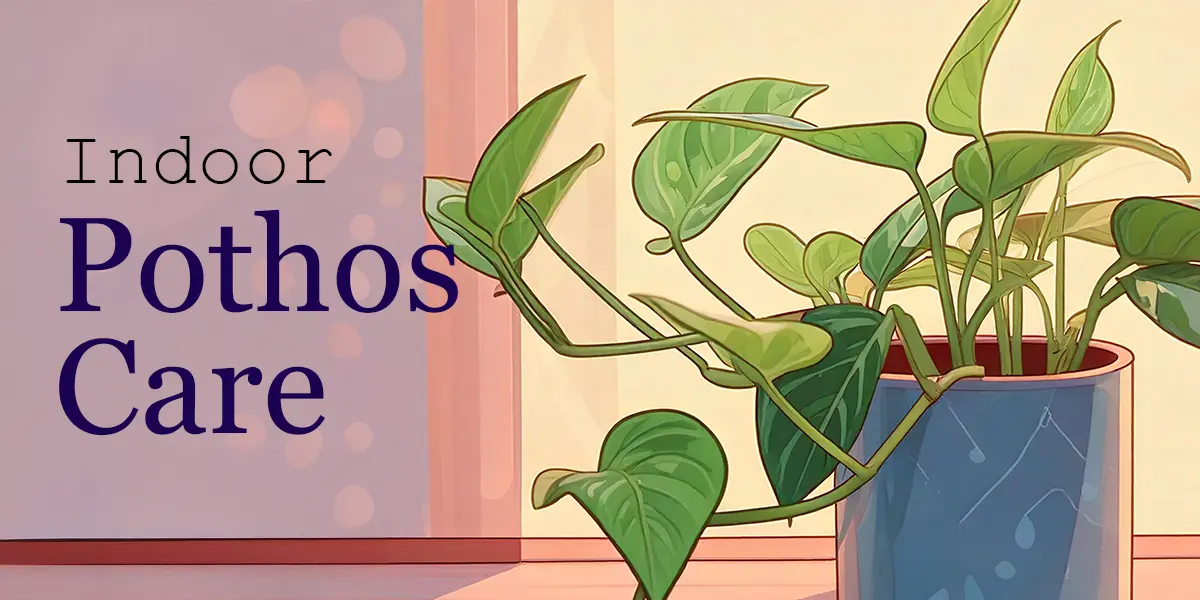Good news, if you’re a plant lover with a brown thumb!
You can always grow pothos, which is hard to kill, just like Steven Seagal.
This air-purifying plant will flourish even in less-than-ideal conditions. In the best conditions, you’ll be rewarded with lush vines and heart-shaped, variegated leaves that will quickly transform your home or office.
Originally from the Solomon Islands in the South Pacific, pothos grows wild in Southeast Asia and Australia. It prefers shady, forested areas where it can climb trees and cover the forest floor. Understanding its natural habitat can help you replicate these conditions at home.
Indoors, pothos plants act as air purifiers and trail gracefully from shelves or hanging baskets. Outdoors, in a suitable climate (USDA zones 10-12), they can grow like crazy but may require more attention to prevent them from overtaking other plants. They’re considered invasive in some regions (although not as invasive as kudzu, the king of invasive species).
Popular Pothos Varieties
- Golden Pothos (Epipremnum aureum) has heart-shaped green leaves with yellow variegation. It’s the most common variety and is incredibly easy to care for.
- Marble Queen Pothos (Epipremnum aureum ‘Marble Queen’) features striking green and white marbled leaves. This variety grows slower than Golden Pothos.
- Jade Pothos (Epipremnum aureum ‘Jade’) is characterized by its solid green leaves. Jade Pothos is perfect for low-light conditions and requires minimal maintenance.
- Neon Pothos (Epipremnum aureum ‘Neon’) bears vibrant, lime-green leaves that bring striking color to an indoor space. It thrives in both bright and low light.
- Pearls and Jade Pothos (Epipremnum aureum ‘Pearls and Jade’) has distinctive white and green patterns on its leaves and grows compactly compared to other types.
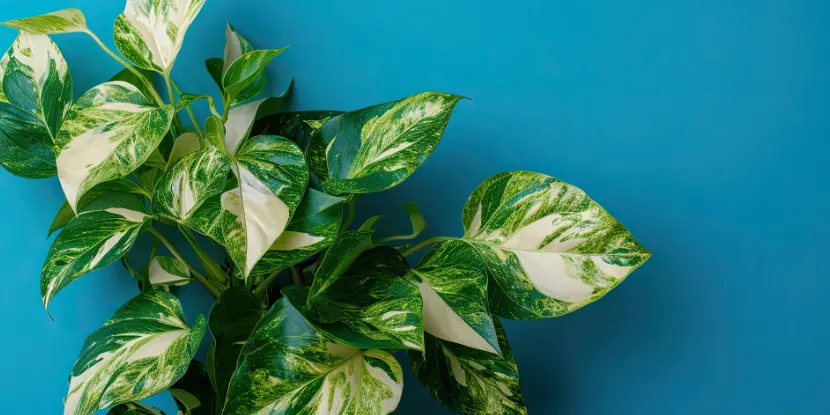
The striking, variegated leaves of a pothos plant.
Light & Temperature
- Pothos plants thrive in bright, indirect light. They can also tolerate low-light conditions, but their growth might slow, and variegated varieties may lose some color patterns. Avoid placing them in direct sunlight, which can scorch their leaves.
- Pothos prefer temperatures between 65°F to 85°F (18°C to 29°C). They don’t tolerate cold drafts or temperatures below 50°F (10°C). Maintain consistent warmth and humidity levels similar to their native rainforest environment.
- To humidify, place a tray of water near the plant or use a humidifier. You can also mist the leaves occasionally.
Soil, Water & Container
- Pothos plants grow best in a loose, well-draining potting mix with some organic matter.
- Use a container with drainage holes. The container should provide enough room for root growth but not be too large, as this can retain too much moisture and harm the roots.
- Water pothos when the top inch of soil feels dry to the touch. Overwatering can lead to root rot.
- Chlorinated water can damage the leaves. If you have no other option, let tap water sit overnight before using it on your plants.
- Repot your pothos every couple of years or when you notice roots growing through the drainage holes. Increase the pot size gradually to prevent overwhelming the plant.
- If using a cachepot without drainage holes for aesthetics, always keep the plant itself in a pot with drainage to avoid standing water.
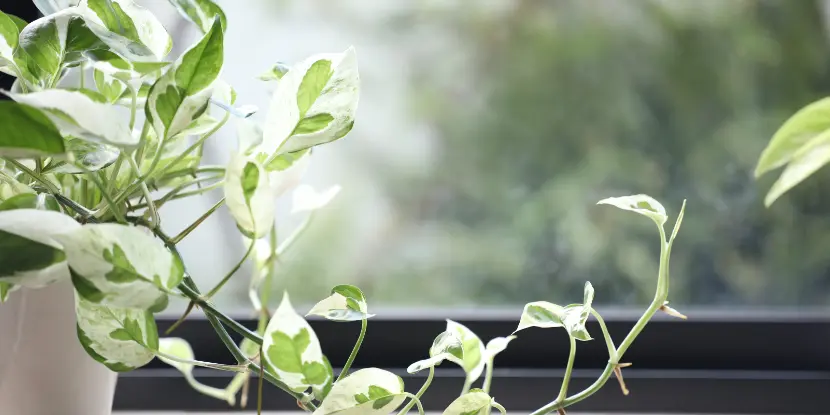
Pothos plants thrive in strong, indirect light, but can also tolerate low-light conditions.
Propagating Pothos
- Choose a healthy vine of your pothos plant with several leaves and nodes. Nodes are small bumps along the stem where leaves and roots grow.
- Cut the stem with clean, sharp scissors or pruning shears about 4–6 inches below a node. Ensure your cutting contains at least 3–4 nodes for growth potential.
- Remove the leaves on the lower third of the stem to expose the nodes where new roots will emerge.
- Place the cutting in a jar or glass of water, submerging the exposed nodes but keeping leaves out of the water.
- Place the jar in a bright, indirect light location. Direct sunlight may damage the cutting, but a bright spot encourages faster root growth.
- Change the water every 7–10 days or whenever it appears cloudy, and keep it filled to the same level to promote root development.
- Once roots are a couple of inches long, typically after 4–6 weeks, plant the cutting in a pot with well-draining potting soil. Water the newly potted pothos thoroughly and continue regular care.
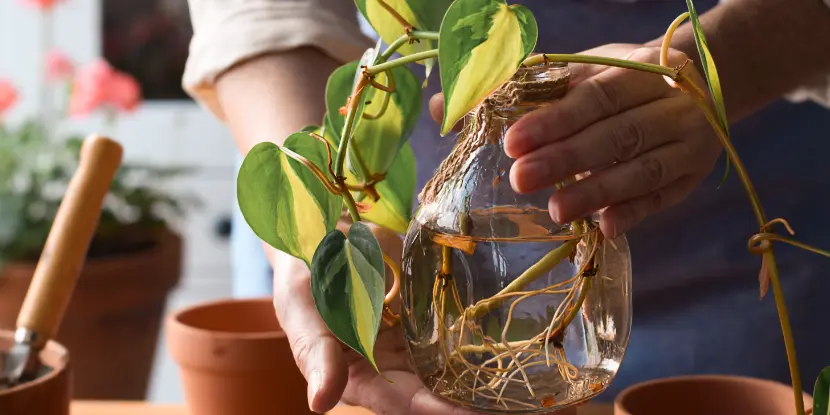
A pothos cutting growing in water.
Fertilizing
- Fertilize your pothos every 4–6 weeks during the growing season, which typically runs from spring through early fall.
- Apply an all-purpose, balanced houseplant fertilizer diluted to half-strength. Liquid fertilizers mixed with water are ideal.
- Water the plant first, then follow with the fertilizer solution. Follow the package instructions for measurements.
- Reduce fertilization in the fall and winter, when the plant’s growth naturally slows. Over-fertilizing during this dormant period can create salt build-up and damage the roots.
Pests & Diseases
- Pothos are generally pest-resistant. However, they can suffer from spider mites, mealybugs, or scale.
- Wipe the leaves with a damp cloth or use insecticidal soap to combat these pests.
- Watch for signs of root rot, often caused by overwatering.
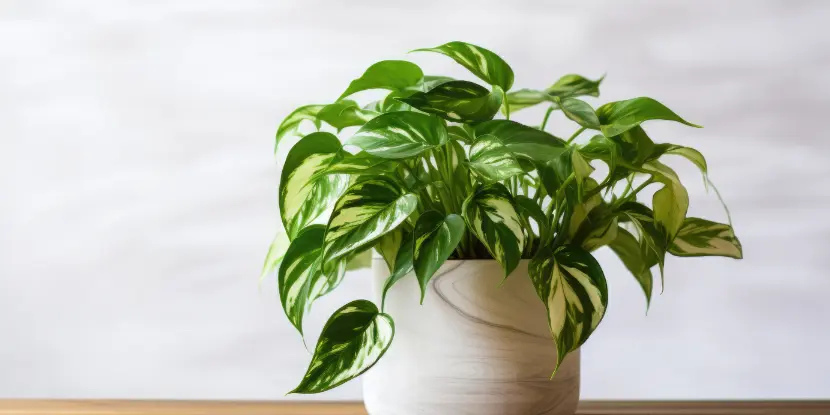
A container-grown pothos plant pruned to a compact shape.
Pruning & Shaping Pothos
- Regular pruning encourages bushier growth and removes any dead or yellowing leaves.
- Use clean scissors to cut just above a leaf node.
- Pruning maintains the plant’s appeal and promotes healthier growth by redirecting energy to new shoots.
Growing Pothos Hydroponically
- Pothos can adapt to hydroponic systems, making them ideal for water gardens or vases.
- Keep the plant’s roots submerged and change the water every two weeks to prevent stagnation.
- Add a liquid fertilizer to the water every few months for nutrients.
FAQs: Pothos Care
Q: Do pothos need a lot of water?
No! Allow the soil to dry out between waterings.
Q: Can pothos thrive in low light?
Yes, they’re one of the best low-light indoor plants.
Q: Is Pothos safe for pets?
Pothos is toxic to pets if ingested, so keep it out of reach of curious cats or dogs.
Q: How fast do pothos grow?
Expect new growth in weeks, with vines extending several inches each month.
Q: Can pothos be grown outdoors?
Yes, pothos can be grown outdoors in USDA zones 10-12. Ensure they’re shaded from direct sunlight and sheltered from cold weather.
Q: How can I make my pothos fuller?
Prune regularly and rotate the plant to encourage bushier growth and even exposure to light, which will help thicken the foliage.
Q: What type of pot should I use for pothos?
To prevent waterlogging, use a pot with drainage holes. A ceramic or plastic pot is fine if it supports healthy drainage.
Q: Can I plant pothos in hanging baskets?
Pothos thrive in hanging baskets, which allow their trailing vines to cascade beautifully. Just ensure the basket has good drainage.

